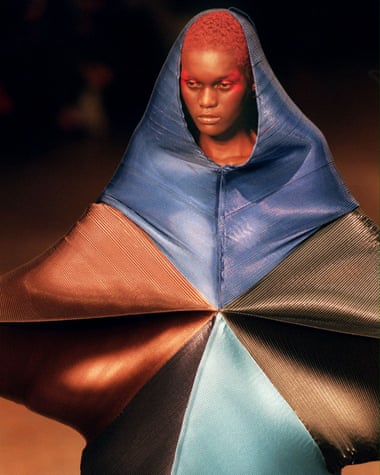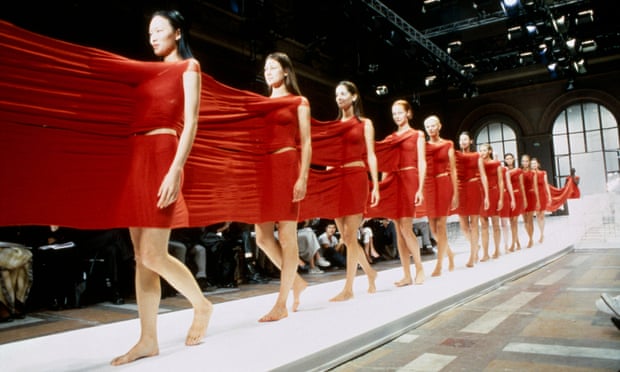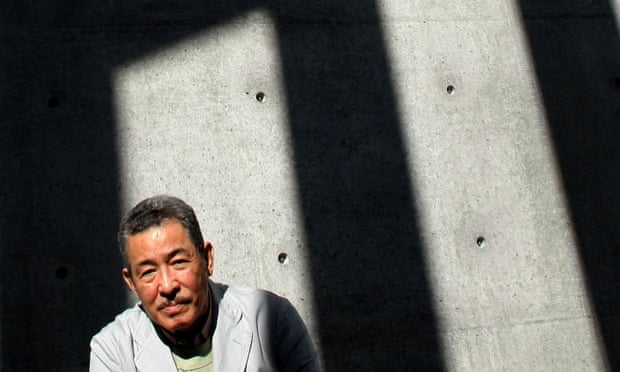The 1960s often attempted to imagine the future of clothes – take a look at the designer Hardy Amies’ wardrobe for Stanley Kubrick’s film 2001: A Space Odyssey, period pieces unmistakably from 1968. But while Amies clad Kubrick’s space hostesses in hard-seamed mod shifts , Issey Miyake was working on his first “constructible clothes” – knit pieces to be layered together at whim. Their seemingly simple shapes are soft, and their novel synthetic yarns sympathetic. They haven’t dated a day, and still look like they might be the future.
Miyake, who has died aged 84, always said he was not interested in fashion, only in design for living. He cared about relationships between people and the cloth enfolding and enwrapping their bodies, about cloth’s fibers and techniques. His simplicity of him referred back, to the ancient principles of Japanese clothing, rectangles off the loom folded and tacked together into garments, and forward, to computer-controlled processes for his 2000 line A-PoC (A Piece of Cloth), which extruded tubular fabric that wearers could cut out into seamless garments.
Miyake regarded craft skills and developing chemistry and technology with equal curiosity – his polyester Bao Bao bags are hard plaques on a mesh backing, tough but flexible like samurai armour. He was an early adopter of digital design for large-scale manufacture by computerized machinery. The more precise and perfect the repeatable process, the closer it came to craft.
His most successful concept, Pleats Please, owed its crimped, tree-bark-like aesthetics to ancient Greek linen garments as imitated by Mariano Fortuny, with his draped 1910s gowns, and its relative affordability to new pleating machines that superheat-bake texture into polyester with a memory.

Miyake’s hundreds of pleated costumes for William Forsythe’s The Loss of Small Detail at Frankfurt Ballet in 1991 fed into the experiment too, and at the line’s 1993 launch, dancer models extracted every joule of kinetic energy out of swirling those garments; Irving Penn joyfully photographed them. In turn, Miyake outfits became gala favorites with ballerinas and classical musicians, guaranteed not to crush when the conductor hugged them. Architects appreciated him too. His most celebrated repeat customer was Apple’s Steve Jobs, who specified to the millimeter the sleeve length of the many black turtlenecks he ordered.
Miyake investigated and delighted in materials, saying: “Material for clothing is limitless: anything can make clothing.” That included the wood cellulose of his 1963 student designs for the Toyo Rayon company; pineapple fiber and rubber; paper, rattan and bamboo – a traditional craftsman wove these into the Miyake bodice that Artforum magazine put on its cover in 1982, the first garment it had deemed worthy of the honour.

Above all, he had unusual respect for materials derived from fossil fuels, seeing plastic, nylon and all the polys not as cheap disposable substitutes for natural substances, but as themselves having unique properties – polyfibres he developed with adventurous manufacturers were machine-washable, uncrushable , stretchy and kind to skin. Hi-tech production processes reduce yarn as well as fabric waste; his garments from him were visually timeless and made to last physically. Miyake never thought of hydrocarbons as infinite resources to burn. Their complex chemistry and potential uses were precious – the heat of long-gone suns made clothes and ingredients for his water-themed perfumes, starting with L’Eau d’Issey in 1992. In the 21st century, his Tokyo Reality Lab recycled plastic bottle tops into durable, wearable cloth.
The Lab was the project of Miyake’s lively old age, after he handed over design responsibility for eight main lines, including décor, and the running of international sales and stores, to personally chosen successors through the 2000s (his firm remains privately owned). Besides being a crucial research and development facility, and a liaison base with craftworkers, machinery-makers, suppliers and digital experimenters, it was an academy of design, where staff who had been with him since he opened his original design studio in 1970 shared expertise with young recruits. His longtime favorite word of him, and practice, was monozukurithe making of things, which meant so much more than manufacturing.

Miyake never expected to reach old age. He was born in Hiroshima, the son of an army officer and a teacher, and evacuated to a nearby small town during the second world war. At 8.15am on 6 August 1945, he was at primary school when he saw the flash of the atomic bomb that destroyed Hiroshima. Seven-year-old Miyake set out alone for the family house, 2.3km from the blast center, searching among the heaped dead and dying for his mother.
She had survived, badly burned, and died three years later, after nursing him through osteomyelitis, the radiation disease he contracted, which lamed him. What sustained Miyake growing up in an impoverished, slowly rebuilding city was painting – too poor to buy brushes, he worked with his fingers – and the Peace Bridge there, with Isamu Noguchi’s profound concrete balustrade symbolizing the future, which he crossed on his way to painting classes. Older fellow students at Hiroshima Kokutaiji high school, some of whom died young of radiation sicknesses, told Miyake about Noguchi, who became his hero (and later, friend) of him. Miyake thought he would die young too, so he took a risk on being a designer.
Images in his sister’s magazines interested him in clothes, but it was not a possible subject of male study in 1950s Japan, and to placate his father he took graphic design at Tama Art University in Tokyo. As a student he wrote in 1960 to the secretariat for the World Design Conference, held in Japan that year, wanting to know why clothes were not part of its programme.

There was nowhere to study couture, so once Japan permitted travel abroad on a tiny budget, he went to Paris in 1965 for a course at the Chambre Syndicale de la Haute Couture, and interned for Guy Laroche and Hubert de Givenchy. The important Parisian education, though, was the student protests of 1968, revolting against the haute-bourgeoisie, usual customers for couture. Miyake sided with the students, wanting to make clothes, both wilder and more useful, for ordinary people, unconstrained by age, size, gender or fit.
Miyake went on to New York in 1969 as an assistant for Geoffrey Beene, to learn about mass production. But in 1970, another bout of radiation-related disease returned him to Tokyo for treatment, where friends loaned him the money to start Miyake Design Studio. In his remarkable first show in Tokyo, a model stripped off many layers until nude, a scandal that alarmed his sponsors and made clear his originality.
In 1973, he began to show in Paris, distinctively different from other Japanese designers arriving there. His regular collections of sculptured, high-end clothes were spectacular, but the real fun came with a change of focus to volume production ready-to-wear lines through the 1990s. They brought him nearer his ideal, unfashionable customers of him.
As well as the Reality Lab, Miyake in “retirement” set up Japan’s first design museum, 21_21 Design Sight, in Tokyo, with the architect Tadao Ando, its enfolding steel roof based on a piece of cloth. Miyake’s own creations have been exhibited and collected by museums, including in London, New York and Paris. Japan awarded him its Order of Culture in 2010.
Miyake kept the sorrows of his childhood private until 2009, and remained secretive about his personal life: his closest companions were his work collaborators, especially the studio president, Midori Kitamura, a former model.